Partner websites
- Australia and the Vietnam War
- Australasian Curriculum, Assessment and Certification Authorities (ACACA)
- Australia’s involvement in the Korean War
- Australian involvement in South-East Asian Conflicts
- Australian Music Examinations Board NSW (AMEB NSW)
- Australians on the Western Front 1914–1918
- Australia’s War 1939–1945
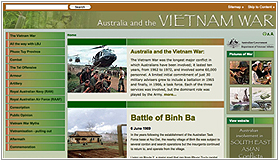
Australia and the Vietnam War – vietnam-war.commemoration.gov.au
This educational site was developed by BOSTES for the Commonwealth Department of Veterans’ Affairs especially for students and teachers of Australian history and geography.
The Vietnam War was the longest conflict in which Australians have been involved; it lasted ten years, from 1962 to 1972, and involved some 60 000 personnel. Millions lost their lives, millions more were made refugees and the disaster that befell the region continues to reverberate today. For Australia the Vietnam War was the cause of the greatest social and political dissent since the conscription referenda of the First World War.
This site provides information on Australia’s role in this conflict.
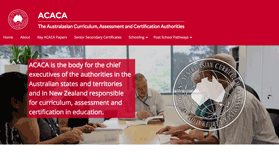
Australasian Curriculum Assessment and Certification Authorities (ACACA) – www.acaca.edu.au
This site summarises the junior secondary curriculum in eight public education systems in Australia as well as in the New Zealand system. It provides an overview of the structure of the secondary system, advice and web links relating to students transferring schools, information about the junior secondary curriculum, subjects and courses, and an outline of the various methods of assessing and reporting student achievement when students complete Year 10.
The information on this website will be useful for:
- students who move interstate or to/from New Zealand
- people who advise secondary school students about curriculum options and career planning
- employers who receive job applications from students educated in another state or territory
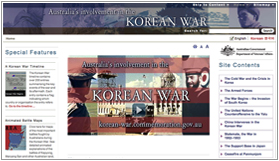
Australia’s involvement in the Korean War – korean-war.commemoration.gov.au
The Korean War began on 25 June 1950 and was the first major war in the larger conflict of the Cold War. Some 17 000 Australians fought in the war and 346 died.
This site covers the major developments of the war and also has special features such as animated maps of the key battles of the war (for example, the Battle of Kapyong and the Battle of Han River), an in-depth look at the war in the air and at sea, the role of Australian nurses, a timeline with more than 200 entries, and video interviews with veterans of the Korean War.
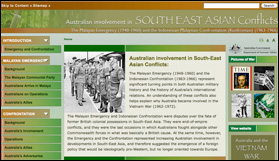
Australian involvement in South-East Asian Conflicts – se-asia.commemoration.gov.au
This site covers the The Malayan Emergency (1948–60) and the Indonesian Confrontation (1963–66) which represent significant turning points in both Australian military history and the history of Australia’s international relations. An understanding of these conflicts also helps explain why Australia became involved in the Vietnam War (1962–72).
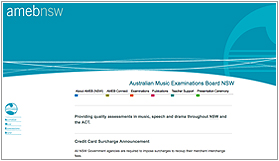
Australian Music Examinations Board NSW (AMEB NSW) – ameb.nsw.edu.au
For nearly 100 years, the Australian Music Examinations Board has been developing a comprehensive system of evaluation in all major areas of Music, as well as Speech and Drama, providing the broadest range of support and assessment available today.
AMEB’s syllabus designers and examiners are experts in their respective fields, and AMEB is the only examination body with formal links to the major Australian universities and Ministers for Education. This is the website of the NSW office of AMEB and it is linked to the AMEB Federal website.
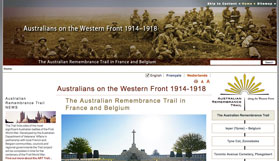
Australians on the Western Front 1914–1918 – ww1westernfront.gov.au
An Australian journey across the First World War battlefields of France and Belgium
This educational site was developed by BOSTES for the Commonwealth Department of Veterans’ Affairs especially for students and teachers of Australian history and geography.
World War I, 1914–18, was the ‘Great War’, the ‘war to end all wars’. In that conflict, the most important battleground was the ‘Western Front’ in France and Belgium where great battles were fought with names that were once household words in Australia - Fromelles, the Somme, Bullecourt, Messines, Passchendaele, Dernancourt and Villers-Bretonneux. Of the more than 290 000 Australians who served in this theatre of war in the AIF, the Australian Imperial Force, 46 000 were either killed in action or died of their wounds. Dotted across the landscape of France and Belgium are hundreds of war cemeteries and memorials where these soldiers lie buried or where their names are listed among those thousands who have ‘no known grave, the ‘missing’.
This site takes you on a historical tour of 40 locations closely associated with the battle experience of the AIF or of more general interest.
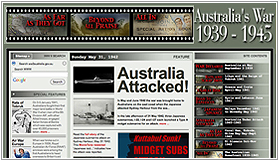
Australia’s War 1939-1945 – ww2australia.gov.au
An educational website developed by BOSTES for the Commonwealth Department of Veterans’ Affairs.
This site charts the course of Australians’ involvement in World War Two.
- Australia at war 3 September 1939
- Libya and the Siege of Tobruk 1941
- Greece and Crete April – May 1941
- Syria and Lebanon June 1941
- Japanese Advance: December 1941 – March 1942
- Australia Under Attack 1940 – 1945
- Coral Sea, Kokoda and Milne Bay May-September 1942
- El Alamein October-November 1942
- ‘All in’ - The Australian homefront 1939 – 1945
- The Coastwatchers 1941 – 1945
- Australian Prisoners of War 1940 – 1945
- Little-known operations 1939 – 1945
- Beachhead Battles (Papua 1942 – 1943)
- The Japanese retreat March 1943-January 1944
- War at Sea 1939 – 1945
- Air war Europe 1939 – 1945
- Last Battles
- Victory (8 May 1945/15 August 1945)
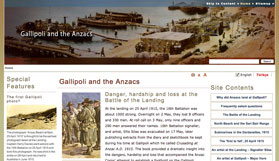
Gallipoli and the Anzacs – www.gallipoli.gov.au
Visit Gallipoli in your classroom. This site was named Best Australian Educational Website in the Australian Excellence in Educational Publishing Awards in 2001. It was developed by BOSTES NSW and the Commonwealth Department of Veterans’ Affairs especially for students and teachers of Australian history and geography.
Many of the photographs, artworks and documents discovered in the archives of the State Library of NSW are published for the first time on this website. A few displays on the site require your browser to have Flash and Shockwave installed, and there are downloadable documents in Acrobat format. See also Australia and the Vietnam War
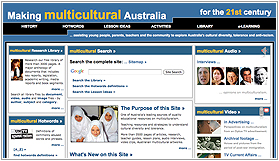
Making Multicultural Australia – www.multiculturalaustralia.edu.au
Making Multicultural Australia is Australia’s leading source of quality educational resources on multiculturalism.
Teachers can explore new strategies to promote cultural diversity, tolerance and anti-racism.
Content:
- more than 3000 pages of articles
- research
- teacher guides
- lesson plans
- audio interviews
- video clips
- Australian multicultural artworks
Major sections:
- A multicultural history of Australia
- Hotwords: Definitions of commonly abused words and phrases
- Lesson ideas for teachers
- Student activities and quizzes: How much do you know about multicultural Australia?
- Multicultural research library: More than 3000 pages of articles, videos, audios, and more
- e-Learning Objects: 26 PowerPoints and FlashPapers
- Links to other multicultural educational resources on the web
Developed by:
- BOSTES
- Department of Education and Training (DET)
- New research is added by Dr Andrew Jakubowicz of the University of Technology, Sydney (UTS).
Awards:
- 2005 Australian Publishers Association Award for Excellence in Educational Publishing as Best Secondary Educational website
- 2006 Bronze in the 54th Book Design Awards in the Best Designed Multimedia Title or Literary or Publishing Website category.
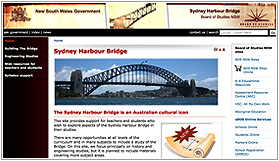
Sydney Harbour Bridge – sydney-harbour-bridge.bostes.nsw.edu.au
The BOSTES Sydney Harbour Bridge site provides support for teachers and students who wish to explore aspects of the Sydney Harbour Bridge in their studies. There are many opportunities at all levels of the curriculum and in many subjects to include a study of the Bridge. On this site, we focus principally on history and engineering studies.
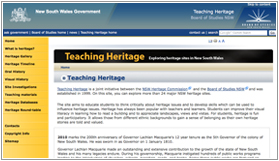
Teaching Heritage – www.teachingheritage.nsw.edu.au
Teaching Heritage is an important website to assist teachers of Australian history and geography. This site was shortlisted for the award of Best Australian Educational Website in the Australian Excellence in Educational Publishing Awards in 2001, and was developed by the Board of Studies NSW for the NSW Heritage Office. The site consists of more than 1000 pages of resource materials, interviews in both audio and video with teachers, historians and heritage professionals and includes 750 photographs of 24 major heritage sites in NSW. These include Government House, Parramatta Park, Grace Building, Cowra POW camp, Richmond Main Colliery, Gleniffer Brae, Rose Seidler House and many more.
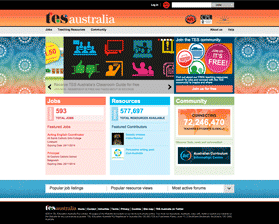
TES Australia – tes.com/au/
TES Australia enables members to share and download a variety of user-generated teaching resources. It is the world’s largest online network of resources, with ten resources downloaded each second. Home to more than 780 000 individually crafted teaching resources, this unparalleled collection helps to guide, inform and inspire educators around the world. Education professionals share and benefit from one another’s resources and connect through the TES Australia Community portal.
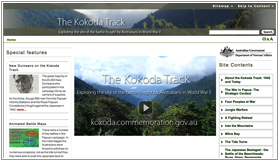
The Kokoda Track – kokoda.commemoration.gov.au
In 1942, along the Kokoda track over the rugged mountains of Papua New Guinea, 625 Australians were killed and over 1000 wounded. The fighting there, against a Japanese invasion force, was perhaps the most significant battle fought by Australians in World War II.
This site presents the major events of this campaign and describes the people, history and topography involved in a defining moment in Australian history. It includes animated maps of key battles and video interviews with Australian Kokoda veterans.
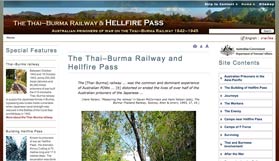
The Thai-Burma railway and Hellfire Pass
Australian prisoners of war on the Thai-Burma railway 1942-45
hellfire-pass.commemoration.gov.au
BOSTES developed this site for the Commonwealth Department of Veterans’ Affairs to assist Australian students and teachers understand the nation’s history.
Since 1945 prisoners of war and the Thai-Burma railway have come to occupy a central place in Australia’s national memory of World War II.
There are good reasons for this. Over 22 000 Australians were captured by the Japanese when they conquered South East Asia in early 1942. More than a third of these men and women died in captivity. This was about 20 per cent of all Australian deaths in World War II. The shock and scale of these losses affected families and communities across the nation of only 7 million people.
This site focuses on Hellfire Pass (Konyu Cutting), the deepest and most dramatic of the many cuttings along the Thai-Burma railway. Not all Australian POWs worked here in 1943. Nor was the workforce in this region exclusively Australian. However, in recent years Hellfire Pass has come to represent the suffering of all Australian prisoners across the Asia-Pacific region.
 NSW Government
NSW Government